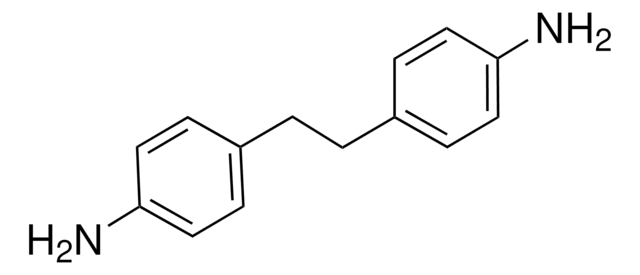369462
4-Aminophenyl disulfide
98%
Sinónimos:
4,4′-Dithiodianiline
About This Item
Productos recomendados
Análisis
98%
formulario
powder
mp
77-78 °C (lit.)
cadena SMILES
Nc1ccc(SSc2ccc(N)cc2)cc1
InChI
1S/C12H12N2S2/c13-9-1-5-11(6-2-9)15-16-12-7-3-10(14)4-8-12/h1-8H,13-14H2
Clave InChI
MERLDGDYUMSLAY-UHFFFAOYSA-N
¿Está buscando productos similares? Visita Guía de comparación de productos
Categorías relacionadas
Descripción general
Aplicación
- A crosslinker in the synthesis of self-healing poly(urea-urethane) elastomers because of its quantitative healing efficiency. These self-healing materials find applications in various fields such as drug delivery, wound healing, and tissue engineering, electronics, aerospace, and coatings.
- A hardener in the formulation of re-processable, repairable, and recyclable epoxy networks due to the presence of dynamic disulfide bonds, which enable the epoxy networks to undergo chemical recycling. These epoxy networks are widely used in various applications which include, composite materials, coatings, adhesives, and fiber-reinforced thermoset composites.
- A crosslinking agent for the development of epoxy vitrimers and carbon fiber composites with enhanced mechanical properties, multi-shape memory capabilities for the potential applications in high-performance materials.
Bioconjugation: The amine group can react with carboxylic acids or their derivatives, making it useful for conjugating biomolecules like proteins and peptides. This is particularly valuable in developing targeted drug delivery systems where the drug is directly linked to a molecule that can home in on cancer cells or other disease sites.
Diagnostic Agents: It can be used to modify surfaces of diagnostic devices, such as biosensors. They can help in the immobilization of biomolecules on sensor surfaces, improving the sensitivity and specificity of detection.
Código de clase de almacenamiento
11 - Combustible Solids
Clase de riesgo para el agua (WGK)
WGK 2
Punto de inflamabilidad (°F)
Not applicable
Punto de inflamabilidad (°C)
Not applicable
Equipo de protección personal
dust mask type N95 (US), Eyeshields, Gloves
Certificados de análisis (COA)
Busque Certificados de análisis (COA) introduciendo el número de lote del producto. Los números de lote se encuentran en la etiqueta del producto después de las palabras «Lot» o «Batch»
¿Ya tiene este producto?
Encuentre la documentación para los productos que ha comprado recientemente en la Biblioteca de documentos.
Los clientes también vieron
Nuestro equipo de científicos tiene experiencia en todas las áreas de investigación: Ciencias de la vida, Ciencia de los materiales, Síntesis química, Cromatografía, Analítica y muchas otras.
Póngase en contacto con el Servicio técnico











